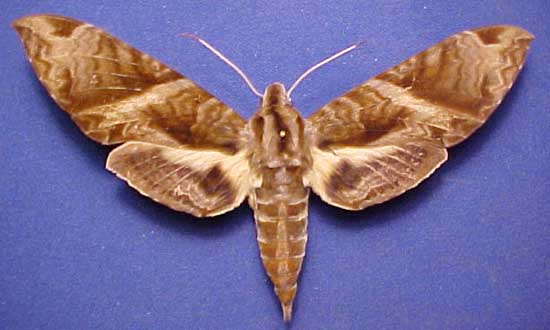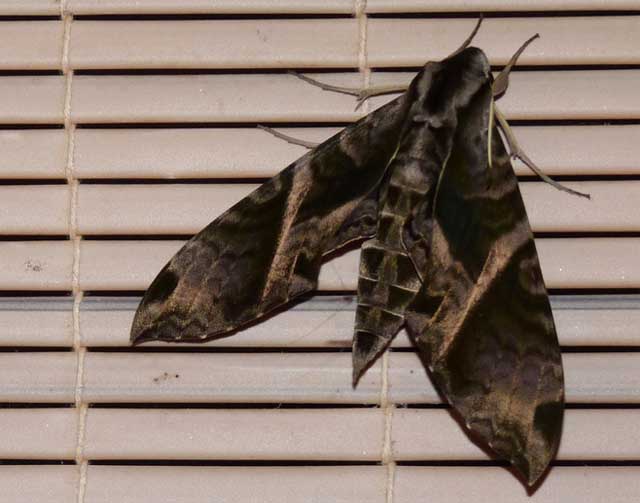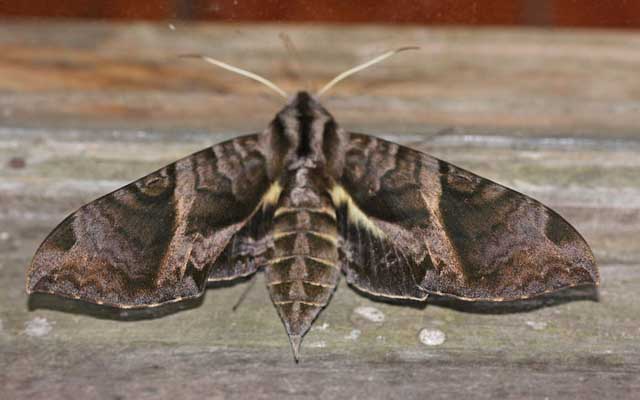Eumorpha cissi
|
|
Updated as per
AN ANNOTATED CHECKLIST OF THE SPHINGIDAE OF BOLIVIA, October 2007
Updated as per CATE (Venezuela, Ecuador: Morona-Santiago: Macas; Peru: Puno: Carabaya; northwestern Argentina); February 5, 2011
Updated as per personal communication with Joakim Johansson (Santa Marta, Magdalena, Colombia, 1950m, March 13, 2011); May 6, 2011
Updated as per personal communication with Attila Steiner (San Pedro, Cusco, Peru, July); June 6, 2011
Updated as per personal communication with Ezequiel Bustos (Shilap revta. lepid. 43 (172) diciembre, 2015, 615-631 eISSN 2340-4078 ISSN 0300-5267), January 4, 2016
Updated as per personal communication with Mario Hec (Santa Marta Mountains, Colombia, February 10, 2019), March 12, 2019
|
Eumorpha cissi
you-MOR-fuhMSIS-eye
(Schaufuss, 1870)
Philampelus

Eumorpha cissi by John Vriesi.
This site has been created by
Bill Oehlke.
Comments, suggestions and/or additional information are welcomed by Bill.
| TAXONOMY:
Superfamily: Sphingoidea, Dyar, 1902
Family: Sphingidae, Latreille, 1802
Subfamily: Macroglossinae, Harris, 1839
Tribe: Philampelini, Burmeister
Genus: Eumorpha, Hubner, [1807]
Species: cissi, (Schaufuss, 1870) |
DISTRIBUTION:
Eumorpha cissi flies in
Venezuela (specimen type locality), and south to
Ecuador: Morona-Santiago: Macas (CATE);
Peru: (Cusco: San Pedro (AS)); Puno: Carabaya: S. Domingo;
Bolivia: La Paz, Cochabamba, Santa Cruz; and
northwestern Argentina: Jujuy; Salta?.
I suspect it is also in eastern Colombia: Magdalena (confirmed JJ) and western Brazil: ?? Amazonas, Acre ??.
Mario Hec provides the following two images from the Santa Marta Mountains, Colombia. Ids are confirmed by Jean Haxaire.

Eumorpha cissi, Santa Marta Mountains, Colombia,
February 10, 2019, courtesy of Mario Hec, id by Jean Haxaire.

Eumorpha cissi, Santa Marta Mountains, Colombia,
February 10, 2019, courtesy of Mario Hec, id by Jean Haxaire.

Eumorpha cissi, Paradise Lodge, San Pedro, Cusco, Peru,
July, 2010, courtesy of Attila Steiner, tentative id by Bill Oehlke
Eumorpha cissi is very similar to E. anchemolus, but cissi ground colour is dark greenish-grey while anchemolus is brown.
Cissi also has a more falcate apex, compared to anchemolus.
The triangular dorsal patches on the abdomen, just below the thorax, are less consticted than in anchemolus.
The pattern of transverse lines and bands on the forewing outer half are stronger than in anchemolus.
Cissi also lacks the strongly contrasting white fringe extending (in anchemolus) from the body to slightly past the dark rhombiform region. In
cissi, the fringe is more buff and does not extend as far.
Also look for two well defined zigzag lines in the pale area along the inner margin between the dark rhombiform region and the anal angle. (CATE)
Note grey hairs on center of upper abdominal segments.

Eumorpha cissi Reserva Natural El Dorado, Santa Marta, Magdalena, Colombia,
March 13, 2011, 1950m, courtesy of Joakim Johansson.
The genus name "Eumorpha" means well-formed.
"Cissi" may come from grape (Cissus).
The pronunciation of scientific names is
troublesome for many. The "suggestion" at the top of the page is
merely a suggestion. It is based on commonly
accepted English pronunciation of Greek names and/or some
fairly well accepted "rules" for latinized scientific names.
The suggested pronunciations, on this page and on other pages,
are primarily put forward to assist those who hear with internal
ears as they read.
There are many collectors from different countries whose
intonations and accents would be different.
FLIGHT TIMES AND PREFERRED FOOD PLANTS:
Eumorpha
cissi adults are on the wing in February-March and October-November in
Bolivia, and posibly at other times. Images have come from Colombia in February and March.
Eumorpha cissi larvae probably feed upon species of grape and other
related vines.
ECLOSION, SCENTING AND MATING:
Pupae wiggle to surface just prior to eclosion. Females call at night, and males fly into the wind to pick up and
track the pheromone plume.
EGGS, LARVAE AND PUPAE:
Larval Food Plants
Listed below are primary food plant(s) and alternate food plants. It is hoped that this
alphabetical listing followed by the common name of the foodplant will
prove useful. The list is not exhaustive. Experimenting with closely
related foodplants is worthwhile.
Use your browser "Back" button to return to the previous page.
Return to U. S. A. Table
Return to Philampelini Index
Return to Sphingidae Index

Eumorpha cissi, Macas, Morona-Santiago, Ecuador,
CATE, on my home computer only.





